How did Romeo get inside Juliet’s courtyard? Is visiting Venice traumatic for flood victims? Why are the Capulet entrance posts covered in chewing gum? When exactly did a medieval refugee camp start to become one of the world’s most famous and influential cities?
A two hour train ride separates Verona — city of love – and Venice — city of water. The Verona train station was surprisingly low key, and Verona itself sports the same homogenous skyline found in most Italian cities. The four-star hotel we wandered into answered our pleas for a city map, which helped us make the rounds: the Arena (mini-Colosseum), the balcony of Romeo and Juliet, the Lamberti clock tower, the bustling plazas, and of course an eatery serving local favorites.
The House of Juliet provided the most entertainment. A stone archway about 20m long leads to the courtyard and creates a massive bottleneck: tourists shuffle along, rubbernecking the piles of chewed gum applied at the entrance and the massive amount of graffiti. A handful stop to add their own declaration of love. The courtyard feels a bit like a college frat party — attendees standing around in packed groups, cameras going off, people constantly feeling up the topless statue in the corner, others hanging off the balcony shouting for their friends to take their pictures…
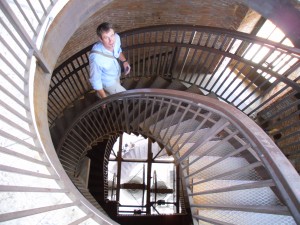
Although Italian skylines are pretty boring, they do guarantee beautiful panoramas from the few towers.
I would later discover, thanks to my befuddlement about how Romeo overcame the dearth of entrance points to get under Juliet’s balcony, that the whole thing is basically a fake. The ruse is working! Thousands of visitors a day come to scribble on the walls, touch Juliet’s breast for good luck, get their photo taken on the balcony, and of course buy customized merchandise in the name of love.
Love is also alive in Venice, if the inscribed locks fastened to the city’s grand canal bridges are to be believed. Our SERVAS hosts, Mario and Rosetta, were quick to point out that Venice isn’t just one island, but actually dozens. Given the lack of real estate and the fact that most of the development occurred several hundred years before the invention of automobiles, Venice is a walk-around or float-around city.
It’s said tribes fleeing a big, organized band of bad guys chose to maroon themselves out on these lagoon islands. They weren’t safe for long. The islands turned into a strategic location on the battle front between the Ottoman and Roman empires: their importance as a trading port did away with any hope of peace and quiet the refugees might have had. Suddenly it was fashionable for the wealthy to construct nice little palaces along the main canal and business began to boom for the artisans and entourages that follow the rich.
Nowadays the few elite have been replaced by a global crowd of middle and upper-class citizens. These folks wander through the narrow lanes, gawk at the stunning St. Mark’s Basilica, get asked to put away their food and remain standing in the massive St. Mark’s square, pay exorbitant sums to float around in a gondola, buy silly overpriced masks outside of carnavale season, and consume thousands of scoops of the world’s best gelato every day. Some even dangle their bare feet into the canals under the guise of cooling off. (I cannot recommend this move. Ew.)
We took advice to “lose ourselves” in the streets of Venice and stumbled upon a Leonardo DaVinci museum. For several weeks we’d passed up numerous showcases on the famous Italian’s life. This time we paid our way in and spent a few hours admiring the art and machinery created by a devout vegetarian man who refused “to be a tomb for other animals.” Born an illegitimate child in Vinci (his name literally means Leonardo of Vinci), he realized early on that many future avenues would be closed to him. Art was one of the few disciplines that might accept someone of his lowly rank. He studied and practiced furiously, participated in his studio’s mechanical engineering installation task force, fell in love with designing machines, and eventually convinced a wealthy ruler to take him on as a military designer and adviser.
Once we tired of Leonardo’s endless and brilliant inventions, we partook in the first of many picnic lunches and water-side birra a la Venice grocery stores. The highlight of our Venice visits was a sunset vaporetto ride. The #1 line motors slowly from stop to stop down the grand canal. In my book, for the area of Venice you get to cover by water, the amount of time you spend floating, the quality of the views, and the angle for photography, the #1 vaporetto beats a gondola ride — hands down. And it’s about $20 cheaper!
When we weren’t wandering Venice with the throngs, we spent time hanging out in a mainland suburb with our SERVAS hosts. They took us to a community festival where Pat tried a horse steak (found on many Italian menus). Then we went to “The Yellow Night” – an annual summer evening that turns the community’s streets into a dance floor and party scene. We spectated official arm wrestling matches, listened to half-a-dozen bands, went late-night shoe shopping for Pat, and had an American flashback watching the line dancers perform. I’ll tell you right now, Italian cowboys are H-O-T-T-T!
Leaving Italy the next morning was bittersweet. Saying farewell to a country I’ve gotten comfortable with always sneaks up on me. I will miss you, Italia. Save me some gelato, will you? ♣
Venice is crazy about funky doorknobs. Proof scattered throughout this facebook album.
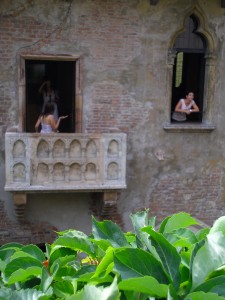


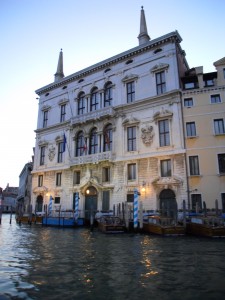
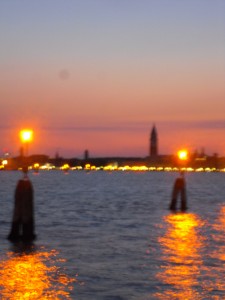
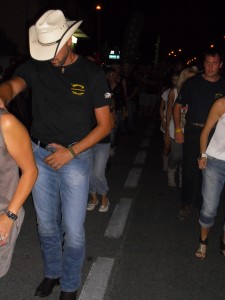




Twitter Facebook Google+ StumbleUpon Reddit Pinterest